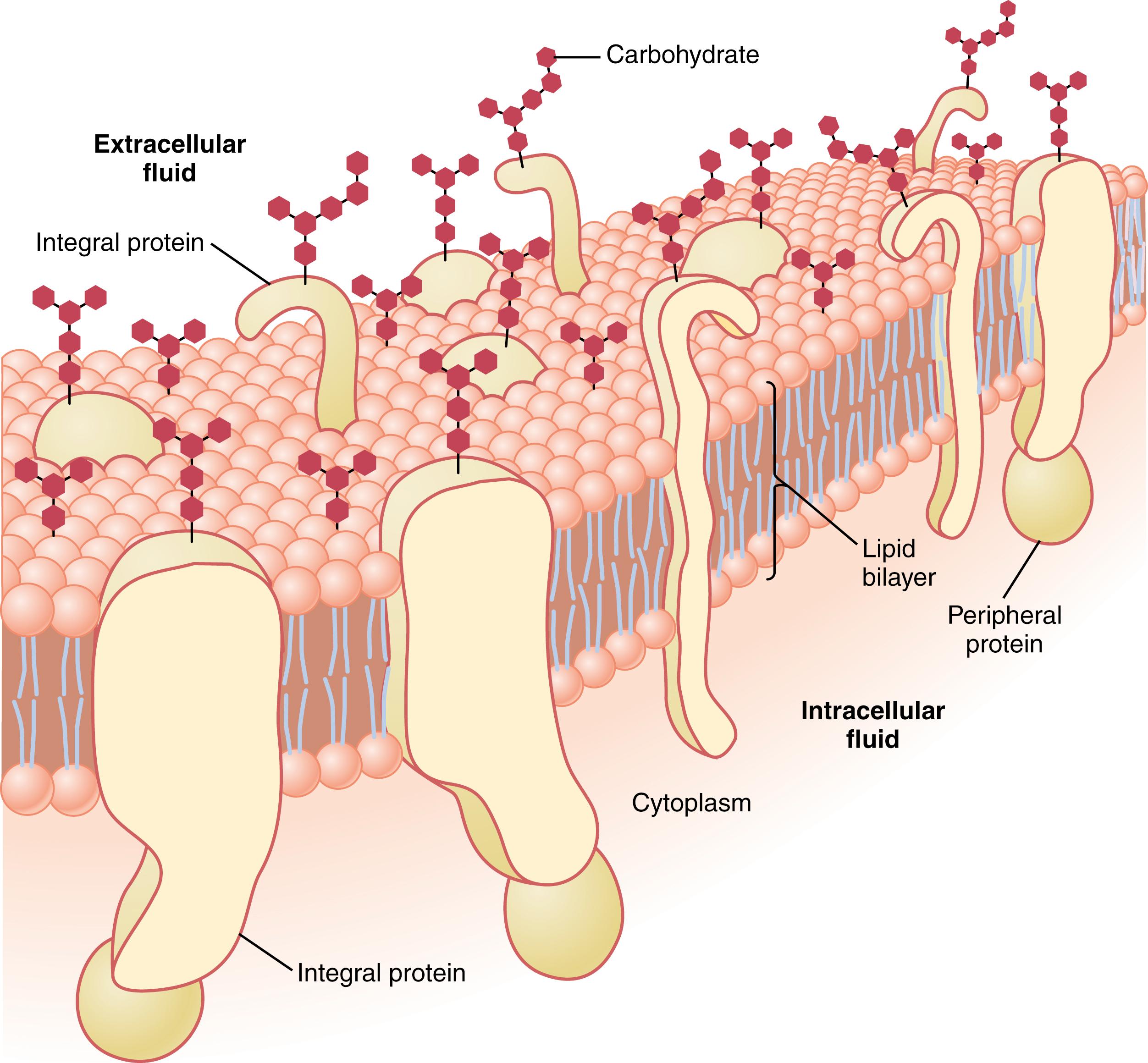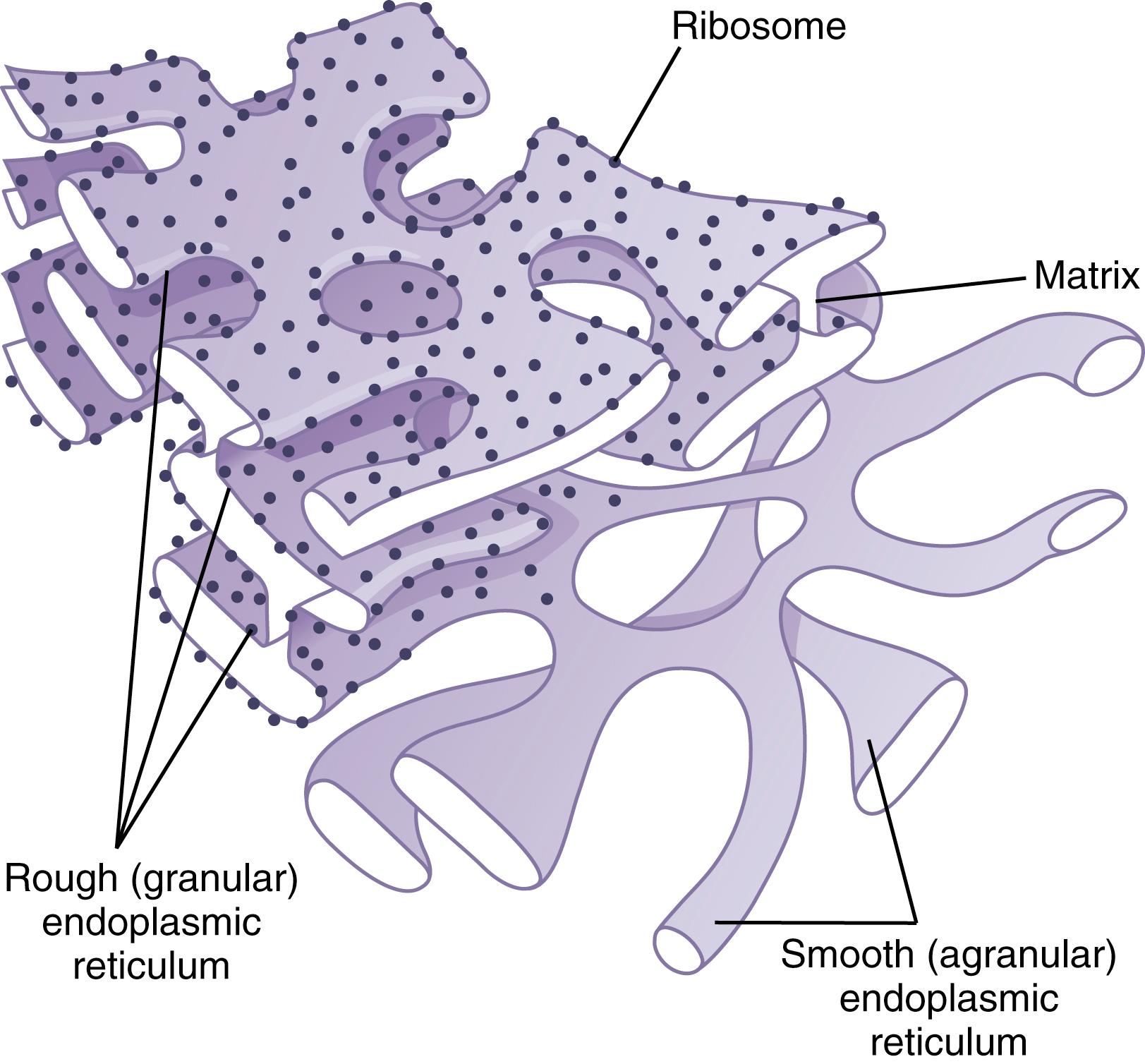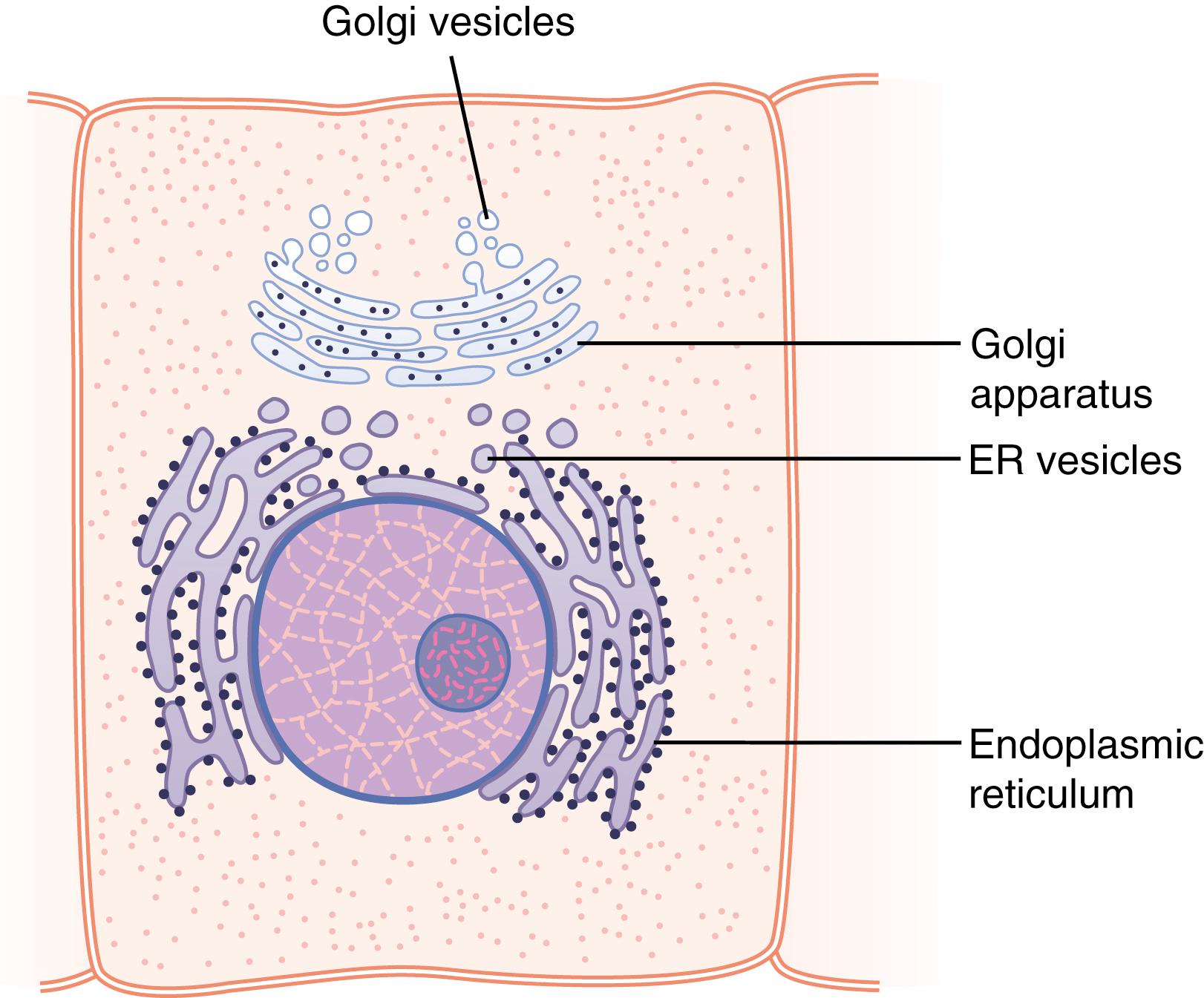Physical Address
304 North Cardinal St.
Dorchester Center, MA 02124
Each of the trillions of cells in a human being is a living structure that can survive for months or years, provided its surrounding fluids contain appropriate nutrients. Cells are the building blocks of the body, providing structure for the body’s tissues and organs, ingesting nutrients and converting them to energy, and performing specialized functions. Cells also contain the body’s hereditary code, which controls the substances synthesized by the cells and permits them to make copies of themselves.
A schematic drawing of a typical cell, as seen by the light microscope, is shown in Figure 2-1 . Its two major parts are the nucleus and the cytoplasm. The nucleus is separated from the cytoplasm by a nuclear membrane, and the cytoplasm is separated from the surrounding fluids by a cell membrane, also called the plasma membrane.

The different substances that make up the cell are collectively called protoplasm. Protoplasm is composed mainly of five basic substances—water, electrolytes, proteins, lipids, and carbohydrates.
Most cells, except for fat cells, are comprised mainly of water in a concentration of 70% to 85%. Many cellular chemicals are dissolved in the water. Others are suspended in the water as solid particulates. Chemical reactions take place among the dissolved chemicals or at the surfaces of the suspended particles or membranes.
Important ions in the cell include potassium, magnesium, phosphate, sulfate, bicarbonate, and smaller quantities of sodium, chloride, and calcium. These ions are all discussed in Chapter 4 , which considers the interrelations between the intracellular and extracellular fluids.
The ions provide inorganic chemicals for cellular reactions and are necessary for the operation of some cellular control mechanisms. For example, ions acting at the cell membrane are required for the transmission of electrochemical impulses in nerve and muscle fibers.
After water, the most abundant substances in most cells are proteins, which normally constitute 10% to 20% of the cell mass. These proteins can be divided into two types, structural proteins and functional proteins.
Structural proteins are present in the cell mainly in the form of long filaments that are polymers of many individual protein molecules. A prominent use of such intracellular filaments is to form microtubules, which provide the cytoskeletons of cellular organelles such as cilia, nerve axons, the mitotic spindles of cells undergoing mitosis, and a tangled mass of thin filamentous tubules that hold the parts of the cytoplasm and nucleoplasm together in their respective compartments. Fibrillar proteins are found outside the cell, especially in the collagen and elastin fibers of connective tissue, and elsewhere, such as in blood vessel walls, tendons, and ligaments.
The functional proteins are usually composed of combinations of a few molecules in tubular-globular form. These proteins are mainly the enzymes of the cell and, in contrast to the fibrillar proteins, are often mobile in the cell fluid. Also, many of them are adherent to membranous structures inside the cell and catalyze specific intracellular chemical reactions. For example, the chemical reactions that split glucose into its component parts and then combine these with oxygen to form carbon dioxide and water while simultaneously providing energy for cellular function are all catalyzed by a series of protein enzymes.
Lipids are several types of substances that are grouped together because of their common property of being soluble in fat solvents. Especially important lipids are phospholipids and cholesterol, which together constitute only about 2% of the total cell mass. Phospholipids and cholesterol are mainly insoluble in water and therefore are used to form the cell membrane and intracellular membrane barriers that separate the different cell compartments.
In addition to phospholipids and cholesterol, some cells contain large quantities of triglycerides, also called neutral fats. In fat cells (adipocytes), triglycerides often account for as much as 95% of the cell mass. The fat stored in these cells represents the body’s main storehouse of energy-giving nutrients that can later be used to provide energy wherever it is needed in the body.
Carbohydrates play a major role in cell nutrition and, as parts of glycoprotein molecules, have structural functions. Most human cells do not maintain large stores of carbohydrates; the amount usually averages only about 1% of their total mass but increases to as much as 3% in muscle cells and, occasionally, to 6% in liver cells. However, carbohydrate in the form of dissolved glucose is always present in the surrounding extracellular fluid so that it is readily available to the cell. Also, a small amount of carbohydrate is stored in cells as glycogen, an insoluble polymer of glucose that can be depolymerized and used rapidly to supply the cell’s energy needs.
The cell contains highly organized physical structures called intracellular organelles, which are critical for cell function. For example, without one of the organelles, the mitochondria, more than 95% of the cell’s energy release from nutrients would cease immediately. The most important organelles and other structures of the cell are shown in Figure 2-2 .

Most organelles of the cell are covered by membranes composed primarily of lipids and proteins. These membranes include the cell membrane, nuclear membrane, membrane of the endoplasmic reticulum, and membranes of the mitochondria, lysosomes, peroxisomes and Golgi apparatus.
The lipids in membranes provide a barrier that impedes movement of water and water-soluble substances from one cell compartment to another because water is not soluble in lipids. However, protein molecules often penetrate all the way through membranes, thus providing specialized pathways, often organized into actual pores, for passage of specific substances through membranes. Also, many other membrane proteins are enzymes, which catalyze a multitude of different chemical reactions, discussed here and in subsequent chapters.
The cell membrane (also called the plasma membrane ) envelops the cell and is a thin, pliable, elastic structure only 7.5 to 10 nanometers thick. It is composed almost entirely of proteins and lipids. The approximate composition is 55% proteins, 25% phospholipids, 13% cholesterol, 4% other lipids, and 3% carbohydrates.
Figure 2-3 shows the structure of the cell membrane. Its basic structure is a lipid bilayer, which is a thin, double-layered film of lipids—each layer only one molecule thick—that is continuous over the entire cell surface. Interspersed in this lipid film are large globular proteins.

The basic lipid bilayer is composed of three main types of lipids— phospholipids, sphingolipids, and cholesterol . Phospholipids are the most abundant cell membrane lipids. One end of each phospholipid molecule is hydrophilic and soluble in water . The other end is hydrophobic and soluble only in fats. The phosphate end of the phospholipid is hydrophilic, and the fatty acid portion is hydrophobic.
Because the hydrophobic portions of the phospholipid molecules are repelled by water but are mutually attracted to one another, they have a natural tendency to attach to one another in the middle of the membrane, as shown in Figure 2-3 . The hydrophilic phosphate portions then constitute the two surfaces of the complete cell membrane, in contact with intracellular water on the inside of the membrane and extracellular water on the outside surface.
The lipid layer in the middle of the membrane is impermeable to the usual water-soluble substances, such as ions, glucose, and urea. Conversely, fat-soluble substances, such as oxygen, carbon dioxide, and alcohol, can penetrate this portion of the membrane with ease.
Sphingolipids, derived from the amino alcohol sphingosine , also have hydrophobic and hydrophilic groups and are present in small amounts in the cell membranes, especially nerve cells. Complex sphingolipids in cell membranes are thought to serve several functions, including protection from harmful environmental factors, signal transmission, and adhesion sites for extracellular proteins.
Cholesterol molecules in membranes are also lipids because their steroid nuclei are highly fat-soluble. These molecules, in a sense, are dissolved in the bilayer of the membrane. They mainly help determine the degree of permeability (or impermeability) of the bilayer to water-soluble constituents of body fluids. Cholesterol controls much of the fluidity of the membrane as well.
Figure 2-3 also shows globular masses floating in the lipid bilayer. These membrane proteins are mainly glycoproteins. There are two types of cell membrane proteins, integral proteins, which protrude all the way through the membrane, and peripheral proteins, which are attached only to one surface of the membrane and do not penetrate all the way through.
Many of the integral proteins provide structural channels (or pores ) through which water molecules and water-soluble substances, especially ions, can diffuse between extracellular and intracellular fluids. These protein channels also have selective properties that allow preferential diffusion of some substances over others.
Other integral proteins act as carrier proteins for transporting substances that otherwise could not penetrate the lipid bilayer. Sometimes, these carrier proteins even transport substances in the direction opposite to their electrochemical gradients for diffusion, which is called active transport. Still others act as enzymes.
Integral membrane proteins can also serve as receptors for water-soluble chemicals, such as peptide hormones, that do not easily penetrate the cell membrane. Interaction of cell membrane receptors with specific ligands that bind to the receptor causes conformational changes in the receptor protein. This process, in turn, enzymatically activates the intracellular part of the protein or induces interactions between the receptor and proteins in the cytoplasm that act as second messengers, relaying the signal from the extracellular part of the receptor to the interior of the cell. In this way, integral proteins spanning the cell membrane provide a means of conveying information about the environment to the cell interior.
Peripheral protein molecules are often attached to integral proteins. These peripheral proteins function almost entirely as enzymes or as controllers of transport of substances through cell membrane pores.
Membrane carbohydrates occur almost invariably in combination with proteins or lipids in the form of glycoproteins or glycolipids. In fact, most of the integral proteins are glycoproteins, and about one-tenth of the membrane lipid molecules are glycolipids. The glyco- portions of these molecules almost invariably protrude to the outside of the cell, dangling outward from the cell surface. Many other carbohydrate compounds, called proteoglycans —which are mainly carbohydrates bound to small protein cores—are loosely attached to the outer surface of the cell as well. Thus, the entire outside surface of the cell often has a loose carbohydrate coat called the glycocalyx.
The carbohydrate moieties attached to the outer surface of the cell have several important functions:
Many of them have a negative electrical charge, which gives most cells an overall negative surface charge that repels other negatively charged objects.
The glycocalyx of some cells attaches to the glycocalyx of other cells, thus attaching cells to one another.
Many of the carbohydrates act as receptors for binding hormones, such as insulin. When bound, this combination activates attached internal proteins that in turn activate a cascade of intracellular enzymes.
Some carbohydrate moieties enter into immune reactions, as discussed in Chapter 35 .
The cytoplasm is filled with minute and large dispersed particles and organelles. The jelly-like fluid portion of the cytoplasm in which the particles are dispersed is called cytosol and contains mainly dissolved proteins, electrolytes, and glucose.
Dispersed in the cytoplasm are neutral fat globules, glycogen granules, ribosomes, secretory vesicles, and five especially important organelles—the endoplasmic reticulum, the Golgi apparatus, mitochondria, lysosomes, and peroxisomes.
Figure 2-2 shows the endoplasmic reticulum, a network of tubular structures called cisternae and flat vesicular structures in the cytoplasm. This organelle helps process molecules made by the cell and transports them to their specific destinations inside or outside the cell. The tubules and vesicles interconnect. Also, their walls are constructed of lipid bilayer membranes that contain large amounts of proteins, similar to the cell membrane. The total surface area of this structure in some cells—the liver cells, for example—can be as much as 30 to 40 times the cell membrane area.
The detailed structure of a small portion of endoplasmic reticulum is shown in Figure 2-4 . The space inside the tubules and vesicles is filled with endoplasmic matrix, a watery medium that is different from fluid in the cytosol outside the endoplasmic reticulum. Electron micrographs show that the space inside the endoplasmic reticulum is connected with the space between the two membrane surfaces of the nuclear membrane.

Substances formed in some parts of the cell enter the space of the endoplasmic reticulum and are then directed to other parts of the cell. Also, the vast surface area of this reticulum and the multiple enzyme systems attached to its membranes provide the mechanisms for a major share of the cell’s metabolic functions.
Attached to the outer surfaces of many parts of the endoplasmic reticulum are large numbers of minute granular particles called ribosomes. Where these particles are present, the reticulum is called the rough (granular) endoplasmic reticulum. The ribosomes are composed of a mixture of RNA and proteins; they function to synthesize new protein molecules in the cell, as discussed later in this chapter and in Chapter 3 .
Part of the endoplasmic reticulum has no attached ribosomes. This part is called the smooth, or agranular, endoplasmic reticulum. The smooth reticulum functions for the synthesis of lipid substances and for other processes of the cells promoted by intrareticular enzymes.
The Golgi apparatus, shown in Figure 2-5 , is closely related to the endoplasmic reticulum. It has membranes similar to those of the smooth endoplasmic reticulum. The Golgi apparatus is usually composed of four or more stacked layers of thin, flat, enclosed vesicles lying near one side of the nucleus. This apparatus is prominent in secretory cells, where it is located on the side of the cell from which secretory substances are extruded.

The Golgi apparatus functions in association with the endoplasmic reticulum. As shown in Figure 2-5 , small transport vesicles (also called endoplasmic reticulum vesicles [ ER vesicles ]) continually pinch off from the endoplasmic reticulum and shortly thereafter fuse with the Golgi apparatus. In this way, substances entrapped in ER vesicles are transported from the endoplasmic reticulum to the Golgi apparatus. The transported substances are then processed in the Golgi apparatus to form lysosomes, secretory vesicles, and other cytoplasmic components (discussed later in this chapter).
Lysosomes, shown in Figure 2-2 , are vesicular organelles that form by breaking off from the Golgi apparatus; they then disperse throughout the cytoplasm. The lysosomes provide an intracellular digestive system that allows the cell to digest the following: (1) damaged cellular structures; (2) food particles that have been ingested by the cell; and (3) unwanted matter such as bacteria. Lysosome are different in various cell types but are usually 250 to 750 nanometers in diameter. They are surrounded by typical lipid bilayer membranes and are filled with large numbers of small granules, 5 to 8 nanometers in diameter, which are protein aggregates of as many as 40 different hydrolase (digestive) enzymes. A hydrolytic enzyme is capable of splitting an organic compound into two or more parts by combining hydrogen from a water molecule with one part of the compound and combining the hydroxyl portion of the water molecule with the other part of the compound. For example, protein is hydrolyzed to form amino acids, glycogen is hydrolyzed to form glucose, and lipids are hydrolyzed to form fatty acids and glycerol.
Hydrolytic enzymes are highly concentrated in lysosomes. Ordinarily, the membrane surrounding the lysosome prevents the enclosed hydrolytic enzymes from coming into contact with other substances in the cell and therefore prevents their digestive actions. However, some conditions of the cell break the membranes of lysosomes, allowing release of the digestive enzymes. These enzymes then split the organic substances with which they come in contact into small, highly diffusible substances such as amino acids and glucose. Some of the specific functions of lysosomes are discussed later in this chapter.
Become a Clinical Tree membership for Full access and enjoy Unlimited articles
If you are a member. Log in here